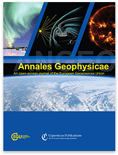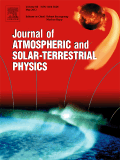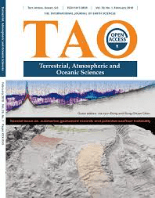
ANNALES GEOPHYSICAE
Scope & Guideline
Unveiling the Mysteries of Our Planet and Universe
Introduction
Aims and Scopes
- Ionospheric Studies:
Research on the ionosphere, including its dynamics, disturbances, and interactions with solar activity, is a core focus. This includes the investigation of ionospheric changes during solar eclipses, geomagnetic storms, and other space weather events. - Magnetospheric Research:
The journal publishes studies on the magnetosphere, including its response to solar wind, magnetospheric dynamics, and the role of magnetic reconnection. This encompasses both observational data and simulations. - Atmospheric Dynamics:
Research on atmospheric phenomena, including gravity waves, tides, and interactions between atmospheric layers and ionospheric processes. Studies often involve complex modeling and observational techniques. - Space Weather Impact:
The journal addresses the impact of space weather on technological systems and natural phenomena, emphasizing the need for understanding solar-terrestrial interactions and their implications. - Planetary Atmospheres:
Investigations into the atmospheres of other planets, including Mars and Venus, are included, focusing on atmospheric composition, dynamics, and the influence of solar activity on these extraterrestrial environments. - Machine Learning and Data Analysis:
The application of machine learning techniques and advanced statistical methods to analyze geophysical data is a growing area of research, enhancing the predictive capabilities and understanding of geophysical phenomena.
Trending and Emerging
- Machine Learning Applications:
There is a notable increase in the use of machine learning techniques for data analysis, anomaly detection, and prediction within geophysical research. This trend underscores the need for innovative approaches to handle large datasets and improve forecasting capabilities. - Interdisciplinary Approaches:
Research that combines insights from various disciplines, such as atmospheric science, space physics, and planetary science, is on the rise. This trend indicates a growing recognition of the interconnectedness of different geophysical systems. - Real-Time Space Weather Monitoring:
The focus on real-time monitoring and forecasting of space weather events has increased, driven by the need to protect technological infrastructure and improve our understanding of solar-terrestrial interactions. - Planetary Atmosphere Studies:
Research into the atmospheres of other planets, particularly Mars and Venus, is gaining prominence. This is driven by advancements in space missions and a renewed interest in comparative planetary science. - High-Resolution Observational Techniques:
There is an emerging trend towards employing high-resolution observational techniques, such as advanced radar systems and satellite data, to gain deeper insights into atmospheric and ionospheric phenomena.
Declining or Waning
- Historical Geomagnetic Studies:
Research focusing on historical geomagnetic events, while still relevant, has seen a decrease in the number of publications. This may be due to a shift towards more contemporary, real-time studies and the application of modern data analysis techniques. - Low-Latitude Ionospheric Studies:
Studies specifically concerning low-latitude ionospheric phenomena, such as sporadic-E layers, have been less frequently published in recent years, possibly due to a growing emphasis on high-latitude and polar research. - Static Models of Atmospheric Dynamics:
The use of static or less dynamic models for atmospheric studies is declining as researchers increasingly opt for more complex, time-dependent models that better capture the variability of atmospheric processes.
Similar Journals

JOURNAL OF ATMOSPHERIC AND SOLAR-TERRESTRIAL PHYSICS
Fostering Interdisciplinary Dialogue in Atmospheric ScienceJournal of Atmospheric and Solar-Terrestrial Physics, published by Pergamon-Elsevier Science Ltd, stands as a pivotal academic resource in the realms of Atmospheric Science, Geophysics, and Space and Planetary Science. With an ISSN of 1364-6826 and an E-ISSN of 1879-1824, this journal encompasses a robust collection of research findings and reviews that address the intricacies of atmospheric processes and solar-terrestrial interactions. The journal has shown consistent academic performance, earning commendable rankings in 2023, including Q3 in Atmospheric Science and Q2 in Geophysics, reflecting its importance for scholarly communication and advancement in these fields. Spanning an impressive convergence of research from 1997 to 2024, it aims to foster interdisciplinary collaboration and inspire innovations among researchers, professionals, and students. Although it currently does not offer open access, the journal is committed to disseminating high-quality content that continues to drive forward our understanding of complex environmental phenomena.

COSMIC RESEARCH
Charting New Territories in Space ExplorationCOSMIC RESEARCH is a prestigious academic journal dedicated to advancing the field of space science, particularly within the domains of aerospace engineering, astronomy, and planetary science. Published by MAIK NAUKA/INTERPERIODICA/SPRINGER, this journal has been a significant contributor to the scholarly discourse since its inception in 1968, with converged years showing robust publication activity until 2024. With a Q4 category ranking in various disciplines, including aerospace engineering, astronomy, and space science, the journal serves as a platform for disseminating innovative research and comprehensive reviews. Although not currently offering open access, COSMIC RESEARCH is renowned for its rigorous peer-review process, ensuring that only high-quality research is shared with the academic community. The journal's ISSN is 0010-9525 and its E-ISSN is 1608-3075. Researchers, professionals, and students alike can benefit from the insights and findings presented in this journal, making it an essential resource for anyone involved in the exploration of cosmic phenomena.

Frontiers in Astronomy and Space Sciences
Exploring the Universe, One Discovery at a TimeFrontiers in Astronomy and Space Sciences is a leading open access journal published by FRONTIERS MEDIA SA, based in Switzerland. Since its inception in 2015, this journal has provided a dynamic platform for researchers, professionals, and students to disseminate their findings across a wide spectrum of topics within the field of astronomy and astrophysics. With an impressive 2023 Impact Factor reflecting its relevance and contribution to the scientific community, it ranks in the Q2 category in Astronomy and Astrophysics, demonstrating a solid reputation among peers. The journal's commitment to open access ensures that all published research is freely available, fostering greater collaboration and knowledge sharing among astronomers worldwide. With a diverse range of articles spanning from theoretical investigations to observational studies, Frontiers in Astronomy and Space Sciences is an essential resource for anyone seeking to explore the wonders of the universe and share innovative ideas that push the boundaries of our understanding.

TERRESTRIAL ATMOSPHERIC AND OCEANIC SCIENCES
Bridging Oceans and Atmospheres Through ResearchTERRESTRIAL ATMOSPHERIC AND OCEANIC SCIENCES, published by SpringerNature, is a distinguished peer-reviewed journal that has been an essential platform for innovative research in the fields of atmospheric science, oceanography, and Earth and planetary sciences since its inception. With an Open Access policy established in 1990, the journal ensures wide dissemination of knowledge, allowing researchers, professionals, and students to access cutting-edge findings without restrictions. Based in Switzerland and featuring a comprehensive coverage from 1996 to 2024, the journal currently holds a Q3 ranking across various categories, indicating its growing significance in the scientific community. Although it is positioned within the 39th percentile in Earth and Planetary Sciences, its commitment to fostering high-quality research makes it a valuable resource for advancing understanding of terrestrial environments and their interconnections. Researchers seeking a platform for their work in atmospheric and oceanic sciences will find TERRESTRIAL ATMOSPHERIC AND OCEANIC SCIENCES to be an ideal venue for sharing their insights with a global audience.

PHYSICS OF THE EARTH AND PLANETARY INTERIORS
Bridging Disciplines in Earth and Space SciencePHYSICS OF THE EARTH AND PLANETARY INTERIORS, published by Elsevier, has been a cornerstone of interdisciplinary research since its inception in 1967. With a strong focus on the intricate processes governing our planet and other celestial bodies, this journal plays a crucial role in advancing knowledge in Astronomy and Astrophysics, Geophysics, and Space and Planetary Science. The journal holds notable impact factor rankings, placing it in the Q1 category for Physics and Astronomy (miscellaneous) and excelling across numerous related fields, including a percentile ranking in the 77th for Physics and Astronomy. It not only caters to established researchers but also serves as a vital resource for students and professionals seeking to remain at the forefront of earth and planetary sciences. Although it does not currently offer open access, the comprehensive and rigorously peer-reviewed articles provide invaluable insights into geophysical phenomena, planetary exploration, and the underlying physics of planetary systems. Be part of the ongoing discourse that shapes our understanding of the universe by engaging with the latest research published in this esteemed journal.

Living Reviews in Solar Physics
Unveiling Solar Secrets, One Review at a TimeLiving Reviews in Solar Physics is a premier open access journal published by Springer International Publishing AG, dedicated to the dynamic field of solar physics. Since its inception in 2004, this journal has provided a platform for comprehensive and up-to-date reviews that cover the latest developments in solar research, making it an invaluable resource for researchers, professionals, and students alike. With an impressive Q1 ranking in both Astronomy and Astrophysics and Space and Planetary Science as of 2023, it ranks in the top 3% of journals in its field according to Scopus. The journal's commitment to open access ensures that groundbreaking research is disseminated widely, fostering collaboration and innovation. As it continues to evolve through to its converged years from 2004 to 2024, Living Reviews in Solar Physics remains a crucial outlet for advancing our understanding of solar phenomena and their implications for astrophysics and planetary science.

Planetary Science Journal
Innovating Knowledge: Bridging Disciplines in Astronomy and GeophysicsThe Planetary Science Journal, published by IOP Publishing Ltd in the United Kingdom, stands at the forefront of research in the fields of planetary science, astronomy, and geophysics. With its open access model established since 2020, this journal aims to democratize access to groundbreaking findings that explore the complex interactions between celestial bodies and their atmospheres, geology, and climates. Recognized for its high quality, the 2023 impact factor places the journal in the prestigious Q1 category across multiple disciplines, including Astronomy and Astrophysics, Earth and Planetary Sciences, and Space and Planetary Science. Ranked favorably among its peers, with notable scores in Scopus rankings, the journal seeks to contribute significantly to advancing our understanding of planetary systems and their formation, encouraging interdisciplinary collaboration among researchers, professionals, and students alike. By fostering a community of innovation and inquiry, the Planetary Science Journal is committed to publishing pioneering research that addresses critical questions of our universe.

Advances in Astronomy and Space Physics
Bridging Disciplines for a Deeper Understanding of Space.Advances in Astronomy and Space Physics is an esteemed journal dedicated to the exploration and dissemination of research in the expansive fields of astronomy and space science. Published by Taras Shevchenko National University of Kyiv, this journal provides a platform for researchers, professionals, and students to share groundbreaking studies and innovations. With an ISSN of 2227-1481, it covers a wide range of subjects including astrophysics, planetary sciences, and space exploration technologies, thereby fostering interdisciplinary collaboration. Although not an Open Access journal, it maintains a commitment to high-quality, peer-reviewed content that contributes significantly to the advancement of scientific knowledge. The journal's mission is to promote sustainable practices in space research while also exploring the implications of discoveries on Earth and beyond. By maintaining rigorous publication standards, Advances in Astronomy and Space Physics aims to serve as a critical resource for those involved in the ever-evolving study of our universe.

Journal of Space Weather and Space Climate
Exploring the Cosmos: Unraveling Space Weather and Climate InteractionsThe Journal of Space Weather and Space Climate is a premier, internationally recognized open-access journal published by EDP Sciences S A, dedicated to advancing the understanding of the intricate interactions between solar and geophysical phenomena. With an ISSN of 2115-7251, this journal has been at the forefront of research since 2011, fostering discussions and disseminating findings related to atmospheric and planetary sciences. The journal ranks in the top quartile for both Atmospheric Science and Space and Planetary Science, highlighting its critical role in the academia with Scopus rankings placing it at #24 out of 104 in Space and Planetary Science and #35 out of 148 in Atmospheric Science. Based in France, it offers seamless access to cutting-edge research, motivating researchers, professionals, and students to contribute to the growing knowledge in this vital field. The journal's commitment to open access ensures that impactful research reaches an extensive audience, promoting collaborative efforts to tackle issues related to space weather and climate change.

Journal of the Korean Astronomical Society
Charting New Frontiers: The Pulse of Astronomical ResearchWelcome to the Journal of the Korean Astronomical Society, an esteemed publication dedicated to advancing the fields of Astronomy and Astrophysics as well as Space and Planetary Science. Established in 1993 and under the reputable auspices of the Korean Astronomical Society, this journal serves as a vital platform for researchers and scholars from South Korea and around the globe to disseminate innovative findings and critical insights. With a commendable Q2 ranking in Astronomy and Astrophysics and a Q3 ranking in Space and Planetary Science, this journal is positioned among the influential voices in its fields, fostering collaboration and knowledge exchange. The journal's rigorous peer-review process ensures that published works contribute significantly to ongoing discussions and developments in astronomical research. While currently not an open-access journal, it remains accessible to the academic community, encouraging readers to stay abreast of the latest advancements in the sciences that elucidate the universe's complexities. Join us in exploring the cosmos through cutting-edge research and scholarly discussion that propels the field forward.